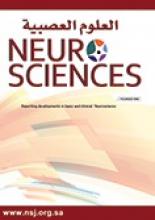To the Editor
In their interesting case report, AlHaj Houssen and Algreeshah nicely described the clinical picture, findings of histopathologic and imaging studies, and treatment plan of Aspergillus sinusitis complicated with meningitis and multiple cerebral infarctions in a 33-year-old immunocompetent Saudi patient.1 I presume that the authors considered their studied patient immunocompetent based on their obvious notion that “multiple investigations were carried out including lumbar puncture, Human immunodeficiency virus(HIV) screening, Perinuclear anti-neutrophil cytoplasmic antibody (P-ANCA), Cytoplasmic antineutrophil cytoplasmic antibodies (C-ANCA) and antinuclear antibody (ANA) were all negative”.1 Despite that explanation, I still presume that jeopardized immune status had greatly contributed to the drastic escalation in the clinical presentation and, importantly, chronic granulomatous disease (CGD) ought to be seriously considered in the studied patient. My presumption is based on the following point: It is explicit that CGD is caused by defects in the genes encoding any of the nicotinamide adenine dinucleotide phosphate (NADPH) oxidase components responsible for the respiratory burst of phagocytic leukocytes. It is a heterogeneous disease with an X-linked recessive form caused by mutations in the CYBB gene encoding the gp91(phox) protein, and an autosomal recessive form caused by mutations in the CYBA, NCF1, NCF2, or NCF4 genes encoding p22(phox), p47(phox), p67(phox), and p40(phox).2 Patients with CGD are at increased risk for a wide range of severe life-threatening bacterial and fungal infections, particularly aspergillosis and excessive inflammation characterized by formation of granulomatous lesions in any body organ.2 It often presents in the first few years of life, however, CGD diagnosed in adult age has been reported and invasive aspergillosis in a previously healthy host might be the first presenting feature of CGD.3,4 The authors obviously mentioned that “biopsy result showed right and left sphenoid sinus; invasive fungal sinusitis (given the presence of septae and acute angling of the PAS+fungal hyphae, Aspergillosis species is favored). Cytology report was negative for malignant cells”.1 I presume that such histopathologic findings didn’t totally exclude CGD as there was no clear-cut notice of the absent of granuloma in the histopathologic report. I presume that the following 2 laboratory tools were solicited to be employed to favor diagnosis of CGD in the studied patient.1 Mutation analysis of genes encoding various NADPH oxidase components.2 Flow cytometric dihydrorhodamine neutrophil respiratory burst assay to evaluate NADPH oxidase function. I presume that if the diagnostic panel of the aforementioned tests was accomplished and it revealed CGD, the case in question could truly widen the spectrum of CGD-associated aspergillosis previously reported in Saudi Arabia.5,6 Regrettably, the studied patient demised before considering the above-mentioned cluster of tests.
Reply from the Author
I agree with you, not every clinical immunocompitant are true nonimmune compitant even in absence of recurrent infection at the same time we analyze the fact that we have. It will be very interesting if it is CGD presented at this age without recurrent significant bacterial or fungal infection. His history of nasal polypremoval that related to CGD will be interesting too, if we agree about the patient clinical condition and his past history. Some of cases reported before showed negative NBT without RT-PCR.
Interestingly, we are looking for sample to detect if he was having CARD9 deficiency as advised by Dr. Michail Lionakis from National Institute of Health.
Ahmad AlHaj Houssen, Fahad Algreeshah
Department of Neurosurgery, National Care Hospital, Riyadh, Kingdom of Saudi Arabia
- Copyright: © Neurosciences
Neurosciences is an Open Access journal and articles published are distributed under the terms of the Creative Commons Attribution-NonCommercial License (CC BY-NC). Readers may copy, distribute, and display the work for non-commercial purposes with the proper citation of the original work.






